Browse using the new Vinous website now. Launch →
Printed by, and for the sole use of . All rights reserved © 2015 Vinous Media
Châteauneuf-du-Pape: Alluring 2023s and Benchmark 2010s
BY NICOLAS GREINACHER | NOVEMBER 14, 2024
Two thousand twenty-three in Châteauneuf-du-Pape was shaped by a series of weather challenges and distinctive growing conditions, setting the stage for what promises to be a delightful year for both reds and whites. In this article, I’ll explore the highs and lows of the season, from the autumn rains in 2022 that rejuvenated vineyards to intense summer heat waves that pushed vines to their limits. As I briefly look ahead to 2024, early signs point to more trials, with high mildew pressure and issues with Grenache due to coulure (poor fruit set).
This report also highlights the vital role of the Mistral wind throughout Châteauneuf-du-Pape's recent history. I’ll examine its impact on everything from disease control to frost prevention, and even how it shapes the daily temperature swings and vine health. As a special treat for Vinous readers, I’ll also revisit the exceptional 2010 vintage, exploring how the wines have matured and which of them are ready to be enjoyed.
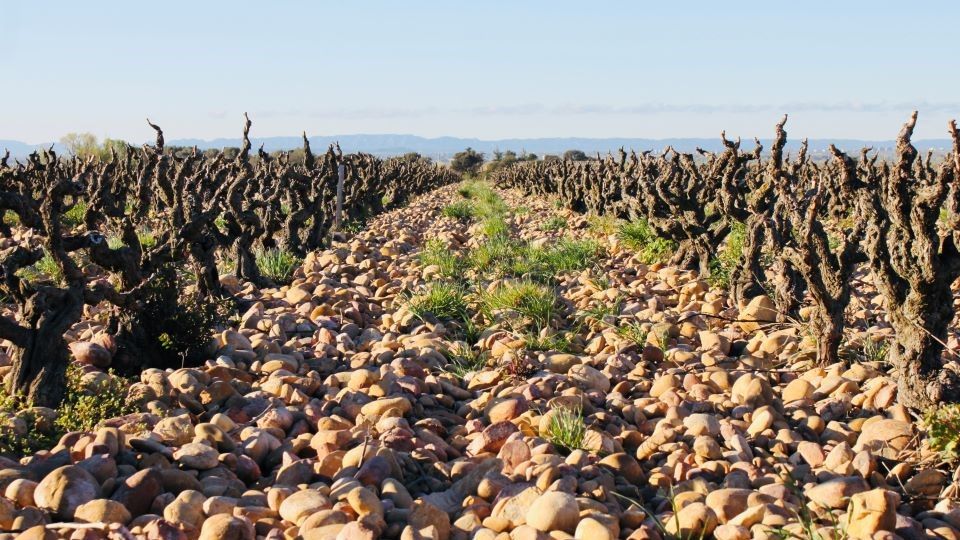
Galets roulés covered Châteauneuf-du-Pape vineyards under a blue sky.
The 2023 Vintage
After the 2022 harvest, a rainy and mild autumn set in, with a little over 200 mm of rainfall from October 18th through the year's end, helping to replenish soil water reserves. A fairly dry winter followed, with significant temperature fluctuations: -2°C (28°F) on December 8, 16°C (61°F) on January 5, and 20.5°C (69°F) on February 18th, as reported by Paul-Vincent Avril of Clos des Papes. By April 4, all the vines had budded, with some already showing a few spread-out leaves. Eight days later, the first inflorescences appeared, but fierce Mistral winds caused some damage. In early May, temperatures remained mild, around 20°C (68°F) in the afternoon. The Mistral was particularly strong, at times reaching speeds over 100 km/h (62 mph). Flowering began on May 15, similar to 2022.
By early June, fruit set was progressing well. With temperatures regularly exceeding 30°C (86°F) and low rainfall, arid conditions were becoming more pronounced. By the end of the month daytime temperatures reached 35°C (95°F). Total rainfall for the first half of the year was around 200 mm. While there were a few outbreaks of downy mildew, the Mistral helped mitigate major damage. Temperatures climbed even higher in early July, with véraison starting around July 18, about a week later than in both 2022 and 2021. On August 22, temperatures peaked at 43°C (109°F), with nighttime lows ranging between 27°C (81°F) and 29°C (84°F). A much-needed 30 mm rain shower on August 26 brought some relief, followed by Mistral winds of 100km/h (62mph) that dried the vegetation and grapes.
Several winemakers observed occasional ripening blockages due to arid conditions, including Nicolas Boiron from Bosquet des Papes. "For my vineyards, the period at the end of July was quite severe in terms of vines shutting down to protect themselves. However, it wasn’t widespread and mostly affected the lower altitude areas. But by the weekend of August 5 and 6, it got extremely hot, and many vines suffered. Syrah took the hardest hit, and I lost roughly 10% of all my Syrah volumes due to that," explained Boiron. Christophe Sabon of Domaine de la Janasse shared a similar experience with Syrah, citing the heatwave after August 15.
Thierry Usseglio of Domaine Pierre Usseglio drew interesting comparisons between Syrah and Grenache in the context of heat-related ripening blockages, explaining, "Syrah is usually further ahead in maturation compared to Grenache. As ripeness progresses, Syrah skins become more fragile. As soon as there is more heat and dryness, they shrivel. So, a lot of Syrah, especially in the southern areas, really suffered—they began to wither and concentrate very quickly. We had to sort out many dried-out grapes. Some Grenache also stopped ripening entirely, but after the brief rain shower at the end of August, ripening continued." Usseglio noted that those who harvested their Grenache early in 2023 obtained higher alcohol levels but not full phenolic ripeness. Those who waited managed to unlock Grenache's full potential, allowing both sugar and phenolic ripeness to converge. Usseglio concluded, “While Grenache halts to protect itself, Syrah doesn’t adapt as well to heat stress and keeps ripening.”
Domaine du Vieux Télégraphe began harvesting white varieties on August 24, following the much-needed rain. Domaine des Bosquets started harvesting his whites on September 4, with daytime temperatures remaining well above 30°C (86°F). Due to the heat, white grape harvesting typically started as early as 6:30 a.m. and stopped by noon, while black variety harvesting halted around 2 p.m., as conditions became unbearable for workers and posed risks of microbial spoilage and oxidation. In the second half of September, several winemakers reported that the cool Mistral wind helped maintain relatively low nighttime temperatures, which preserved natural acidity better than in the preceding 2022 season.
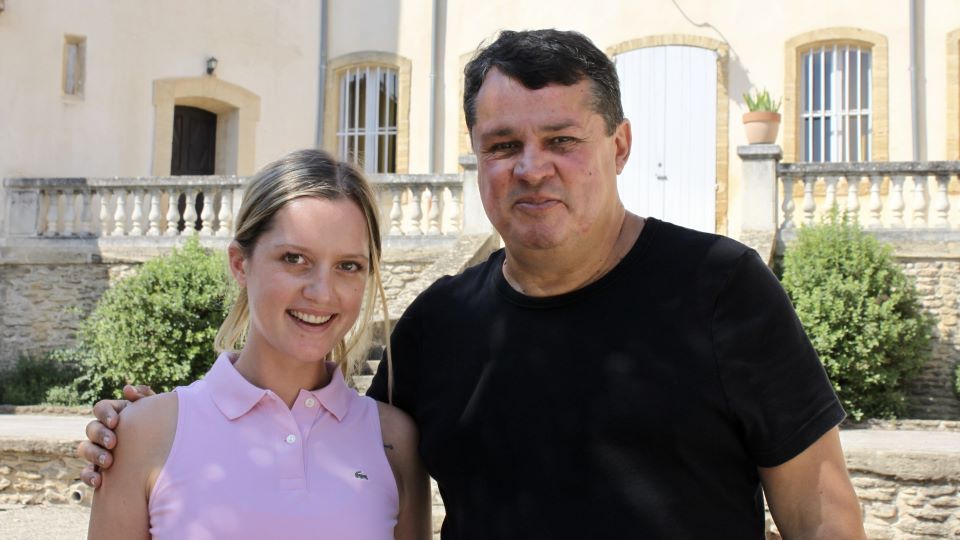
I was warmly welcomed to Château de Vaudieu by Laurent Bréchet and his daughter Elise.
Sorting was crucial, as usual, but not as difficult as in previous vintages. According to Christophe Sabon of Domaine de la Janasse, "The grapes that were dried and shriveled were quite easy to separate from the healthy ones, especially compared to rot-affected grapes, which are much harder to handle." Sabon noted that 2023 could have been an exceptional vintage were it not for the summer heat spikes, which caused some disruptions, especially with Syrah. However, the major clay soil terroirs of Châteauneuf-du-Pape were less affected than sandier soils, as clay retains moisture more efficiently. By the end of October, all black varieties had been harvested, with winemakers reporting healthy yields of 32 to 35 hectolitres per hectare (hl/ha). These numbers are at the upper end of the appellation’s 35 hl/ha limit, and well above the 27.5 hl/ha achieved 2022 or the 27.4 hl/ha obtained in 2021.
Based on the 85 unique barrel samples I assessed for this report, the red 2023 Châteauneufs generally range from good to very good in quality. As I reviewed my tasting notes, I frequently encountered descriptors like alluring, sexy, perfumed and juicy. These wines focus more on red and black fruit complexity and overall accessibility rather than structure. While the 2022s broadly require extended cellaring, the 2023 reds should shine earlier on. Although generally not set to be as long-lived as the 2022s, the finest 2023s are built to last. This year's standout producers include Bosquet des Papes, Clos des Papes, Clos Saint-Jean, Domaine La Barroche, Domaine Pierre Usseglio, Domaine Roger Sabon and Famille Isabel Ferrando. That said, the reds from Château Rayas and Domaine de la Vieille Julienne had not yet completed their fermentations at the time of my visit, and the Hommage à Jacques Perrin from Château de Beaucastel wasn’t yet fully assembled, which is why those three potential high-flyers are not included in my report.
Four months prior to my visit, I tasted a dozen white Châteauneuf-du-Papes from the 2023 vintage. From that initial glimpse, I felt the style and quality to be similar to that achieved in 2022. Now that I’ve tasted 75 finished samples, I’ve confirmed that assessment, meaning 2023 is also a good to very good vintage for white Châteauneuf-du-Pape. Several winemakers reported higher natural acidity levels in the 2023 than in 2022, reducing the need for acidification. Château de Beaucastel, Domaine La Barroche, Famille Isabelle Ferrando and Clos des Papes crafted the finest white wines of the vintage. That said, Châteauneuf-du-Pape Blanc is best consumed soon after release, up to around eight years of bottle age. While there are always exceptions, they are rare.
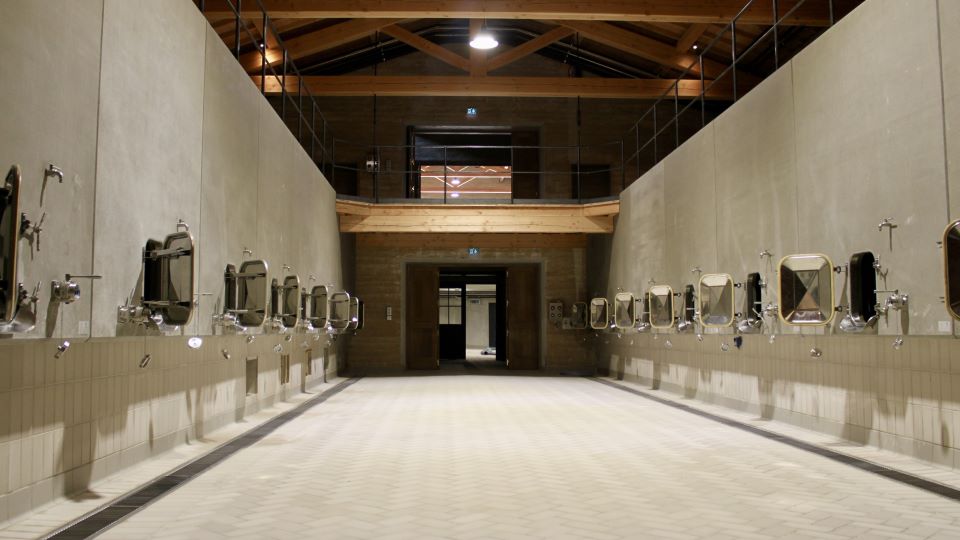
Pristine, brand-new concrete tanks at Château de Beaucastel.
A Look At 2024
In 2024, Europe experienced not only a warm year but also a notably humid one, which significantly increased mildew pressure in vineyards. Winemakers had to stay vigilant throughout the growing season, carefully managing their treatment schedules. However, the greatest challenge for the 2024 Châteauneuf-du-Pape vintage is likely to be coulure, a condition where a significant portion of flowers fail to develop into fruit, caused by an imbalance in carbohydrate levels within the vine. The bad news for Châteauneuf-du-Pape is that Grenache, the region’s key variety, is particularly prone to coulure.
“I don’t think 2024 will be the year for Grenache,” says Emmanuel Reynaud of Château Rayas. “Syrah, on the other hand, is looking better this year, more so than in 2023. The Syrah has been beautiful since the beginning of the season.” This could mean higher proportions of Syrah and Mourvèdre in red Châteauneufs in 2024, leading to fleshier, spicier, darker wines with more apparent structure. But as the wines are still fermenting at the time I’m writing this report, much can still change. It’s too early to tell which direction the 2024s are heading.
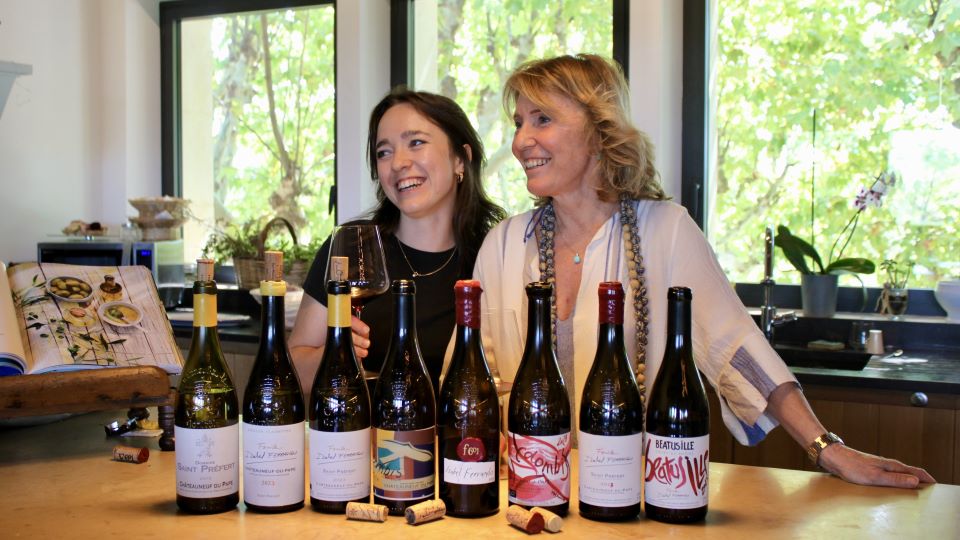
Isabel Ferrando with her daughter Guillemette in front of a stellar lineup.
Mistral - The Rhône Valley’s Indispensable Wind
The Mistral is a powerful, cold wind that blows down from the north along the French Rhône valley, reaching speeds of up to 130 km/h (80 mph). It is particularly strong in the winter months. As it travels through the valley, its force intensifies due to the narrowing landscape. In the flatter region of Châteauneuf-du-Pape, there is little protection from this wind, making it a significant factor in the area's viticulture.
The Mistral creates a drying effect that yields favorable conditions for organic or biodynamic viticulture. César Perrin of Château de Beaucastel notes, “It’s much easier to be organic here compared to Bordeaux and Burgundy due to the presence of the Mistral, which dries everything. Without the Mistral, we would need far more workers to spray against fungal diseases in our vineyards.” Thierry Usseglio recalls the Mistral being warmer than usual in 2023, to the point where it almost caused defoliation. According to Usseglio, this made controlling yields imperative: “In this hot environment, at times intensified by the Mistral, the vines simply couldn’t maintain all their leaves and grape clusters.”
Isabel Ferrando agrees with Usseglio, explaining, “The Mistral can burn and over-concentrate the fruit, disrupting balance and worsening drought conditions. That’s the issue with the Mistral during summer and sometimes during harvest, as well. On the positive side, the Mistral protects us from disease and generally brings a cooling effect. After rain, the wind picks up and dries everything, eliminating excess humidity and discouraging the development of fungi. Châteauneuf-du-Pape wouldn’t be Châteauneuf-du-Pape without the Mistral.”
Emmanuel Reynaud highlights the Mistral’s effect on diurnal range, explaining, “The Mistral is beneficial because it causes temperature fluctuations. The variation between cool nights and warm days helps the grapes ripen while also maintaining freshness and acidity.” During a visit to Château de Fonsalette, roughly 30 minutes north of Châteauneuf-du-Pape by car, Reynaud mentions that the Mistral strengthens between Montélimar and Bollène, and the vineyards of Château de Fonsalette are situated on the first hill in its path. Reynaud adds, “The wind is cold and strong, creating a rather austere environment, which is why ripening here is up to two weeks later compared to Châteauneuf-du-Pape.”
Christophe Sabon claims that the Mistral is 90% beneficial to the region overall: “Occasionally, the Mistral can be annoying in spring during flowering and fruit set when we get strong cold gusts, but it may save us from spring frost. In 2024, without the Mistral’s help, we would have experienced severe frost damage.”
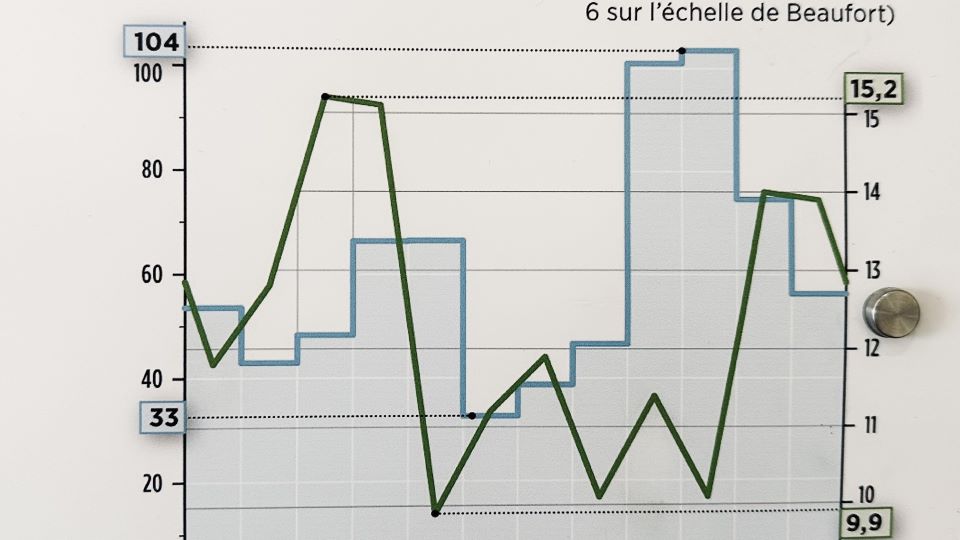
Historic Mistral explanation chart at Domaine Roger Sabon, showing in green the number of days per month when the Mistral blows over 47 kmh (29mph).
Didier Negron of Domaine Roger Sabon emphasizes that role in protecting against spring frost: “Often, in February, we experience eight to ten days of warm weather where people think it’s spring, wearing t-shirts, only for the temperature to drop by 15 degrees two weeks later, as happened in 2022. Even here in the south, as soon as you move a bit away from the Rhône, the risk of frost becomes more frequent. The advantage of being near the Rhône is that we often have air currents that are enough to reduce frost risk. The Mistral helps protect us from that.”
The Mistral is an integral part of the warm Mediterranean climate in Châteauneuf-du-Pape, along with the sunshine, geology and grape varieties. It can be both a helpful and challenging natural force.
Revisiting 2010
I consider 2010 to be one of the finest vintages in the history of the Southern Rhône, period. My personal cellar is heavily stocked with those wines. I first tasted many of them from barrel, then again right after release, before burying them deep in my basement. Over the past year, I’ve often wondered whether it’s time to start opening them. When I drove down to Châteauneuf-du-Pape at the end of this summer, I decided the time had come, but I wanted to do it right. So, whenever time allowed, I asked every winemaker I visited if they’d be willing to pour a sample of their 2010 reds. The result? Thirty-six of the most coveted 2010 Châteauneufs, including two whites. But before we dive into what’s in the glass, let’s take a quick look back at the key events of the growing season.
Every winemaker with whom I spoke about 2010 vividly recalled the impact of coulure, which hit Grenache hard, in some cases reducing yields by as much as 40%. As a result, many of the wines from 2010 contain a higher-than-usual amount of Mourvèdre and Syrah. The weather was warm but not excessively hot, with cool nights that helped maintain acidity and freshness. Due to coulure, yields averaged 27 hl/ha—well below the appellation’s limit. The increased proportions of Mourvèdre and Syrah, combined with the concentration from lower yields, pushed the wines’ flavor profiles toward darker fruit. Laurence Féraud of Domaine de Pegau pointed out that the Grenache berries that did develop were quite small with a high skin-to-pulp ratio, leading to even more concentration.
Tasting these wines felt like stepping into a time capsule, back to an era where power and concentration were highly prized by critics and consumers alike (and sometimes pushed to extremes). Compared to today’s practices, major viticultural and winemaking differences existed at the time, including later harvesting, heavier extraction, less use of stems or whole clusters during fermentation and more frequent employment of new oak in maturation. A selection of the top 2010 cuvées verge on being too concentrated and intense, while most of the standard bottlings hit the sweet spot between power, structure and freshness. More than half of the wines have entered their broad drinking windows, while others are better left untouched for now.
That said, the very best 2010s are indeed the top cuvées, walking a fine line between immense power and enough freshness to keep them balanced. A standing ovation goes to the wines of Château de Beaucastel, Clos des Papes, Clos Saint-Jean, Domaine de la Janasse, Domaine de la Vieille Julienne, Henri Bonneau, Domaine du Pegau, Domaine La Barroche and Domaine Saint-Préfert. These iconic estates produced some of the best wines in recent history. And although they’re all brilliant, the 2010 Château Rayas trumps them all. When I last tasted it in spring 2022, it was fairly closed and not yet ready to reveal its brilliance. But this time, it was an entirely different story. Perfection in the glass doesn’t need to be searched for or uncovered—it finds you.
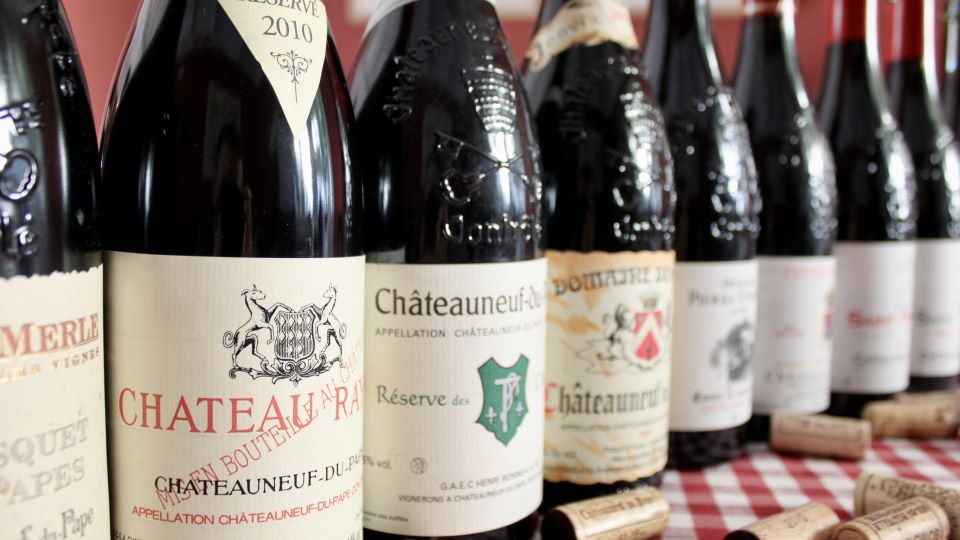
The 2010 vintage is one of the greatest in Châteauneuf-du-Pape's recent history, with one wine earning a perfect score.
Final Thoughts
The 2023 vintage in Châteauneuf-du-Pape reflects the region's ongoing ability to adapt to wider climatic changes and the distinct challenges of each growing season. The balance of resilience and nuance seen in these wines, particularly with the interplay of the Mistral and its impact on viticulture, speaks to the unique nature of this historic appellation. While 2023 offers early appeal with its alluring reds and generous whites, the potential for greatness lies in the hands of producers who continue to push boundaries. Lastly, the 2010s are a stark reminder of the lasting power of Châteauneuf-du-Pape, pointing to a future that suggests a continued journey of excellence.
I tasted the majority of the wines in this report in Châteauneuf-du-Pape in August 2024, with follow-up tastings at my office in Zurich.
© 2024, Vinous. No portion of this article may be copied, shared or re-distributed without prior consent from Vinous. Doing so is not only a violation of our copyright, but also threatens the survival of independent wine criticism.
You Might Also Enjoy
Châteauneuf-du-Pape 2022: Bring It On, Nicolas Greinacher, June 2024
Châteauneuf-du-Pape New Releases: Welcome to the Pleasuredome, Nicolas Greinacher, June 2023
Northern Rhône: Where Diversity Ignites the Senses, Nicolas Greinacher, March 2024
Gigondas: The Southern Rhône Jewel Shines and Adapts, Nicolas Greinacher, January 2024
Vacqueyras New Releases: Walking the Underdog, Nicolas Greinacher, November 2023
Show all the wines (sorted by score)
- Aimé Arnoux
- Alain Jaume
- Ambrine
- Amédée
- André Brunel
- Arnoux & Fils
- Bonpas
- Bosquet des Papes
- Brotte
- Château Cabrières
- Château de Beaucastel
- Château de Fonsalette
- Château de la Gardine
- Château de la Négly
- Château de Manissy
- Château de Nalys
- Château de Vaudieu
- Château Fortia
- Château Gigognan
- Château la Négly
- Château La Nerthe
- Château Les Pins
- Château Maucoil
- Château Mont-Redon
- Château Mont-Thabor
- Château Rayas
- Château Simian
- Château Sixtine
- Clos Bellane
- Clos de l'Oratoire des Papes
- Clos des Papes
- Clos du Calvaire
- Clos du Mont-Olivet
- Clos Saint-Jean
- Clos Saint-Michel
- Clos St Antonin
- Domaine Albin Jacumin
- Domaine André Mathieu
- Domaine Arnia
- Domaine Barville/Brotte
- Domaine Bois de Boursan
- Domaine Chante Cigale
- Domaine Christophe Mestre
- Domaine Comte de Lauze
- Domaine de Beaurenard
- Domaine de Cristia
- Domaine de Ferrand
- Domaine de Fontavin
- Domaine de la Charbonnière
- Domaine de la Côte de l'Ange
- Domaine de la Croze-Granier
- Domaine de la Janasse
- Domaine de la Mordorée
- Domaine de la Vieille Julienne
- Domaine de Marcoux
- Domaine de Panisse
- Domaine de Pignan
- Domaine des 3 Cellier
- Domaine des Pères d'Eglise
- Domaine des Sénéchaux
- Domaine du Bois de Saint-Jean
- Domaine du Grand Tinel
- Domaine du Pegau
- Domaine du Père Caboche
- Domaine Duseigneur
- Domaine du Vieux Télégraphe
- Domaine Élodie Jaume
- Domaine Galevan
- Domaine Grand Veneur
- Domaine Henri Bonneau
- Domaine Jean Royer
- Domaine La Barroche
- Domaine La Boutinière
- Domaine La Crau des Papes
- Domaine La Mereuille
- Domaine Olivier Hillaire
- Domaine Paul Autard
- Domaine Pierre Usseglio
- Domaine Raymond Usseglio & Fils
- Domaine Roger Perrin
- Domaine Roger Sabon
- Domaine Saint-Laurent
- Domaine Saint-Préfert
- Domaine Saint Siffrein
- Domaine Santa Duc
- Domaine Serre Des Mourres
- Domaine Tour Saint-Michel
- Domaine Val de l’Orme
- Dom Brial
- Famille Brunier
- Famille Gassier
- Famille Isabel Ferrando
- Famille Tardieu
- Gabriel Meffre
- J&G Meffre
- La Barroche
- La Bastide Saint-Dominique
- La Ferme du Mont
- Le Clos du Caillou
- Les Quelles de La Coste
- Le Vieux Donjon
- Louis Bernard
- Maison Bouachon
- Maison Chapoutier
- Marrenon
- Mas de Boislauzon
- Ogier
- Pierre Amadieu
- Rotem & Mounir Souma
- Saint Theodoric
- Villa Safranier
